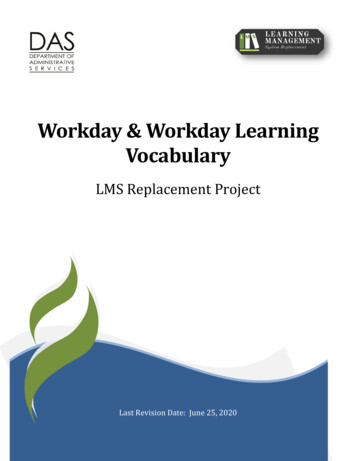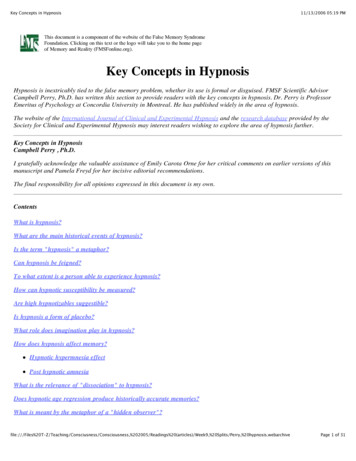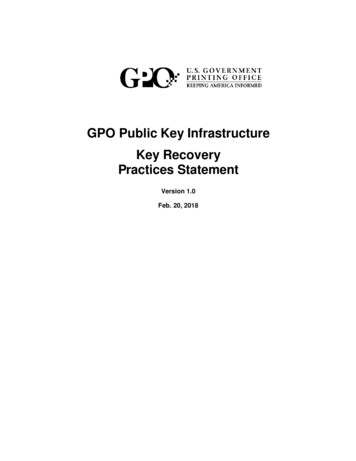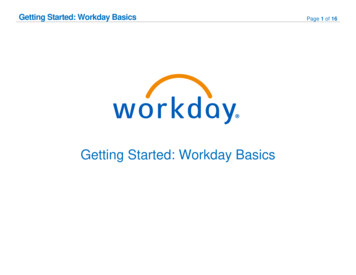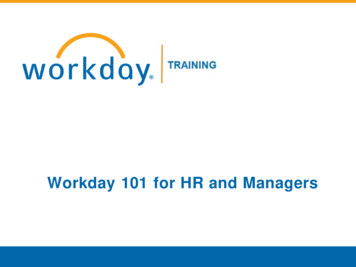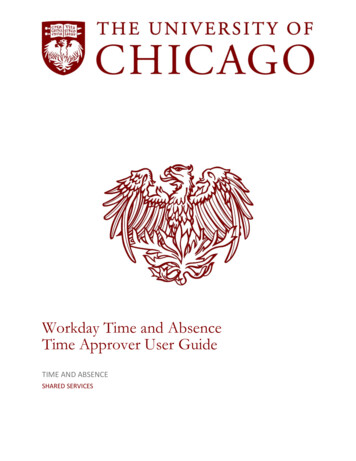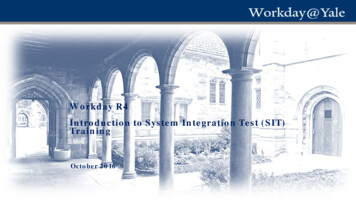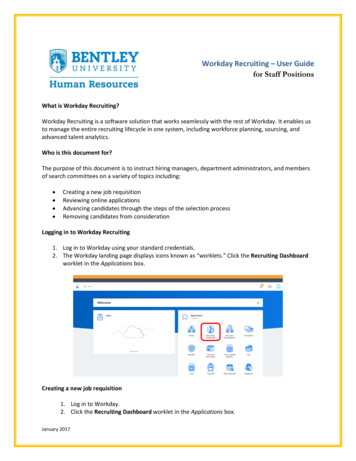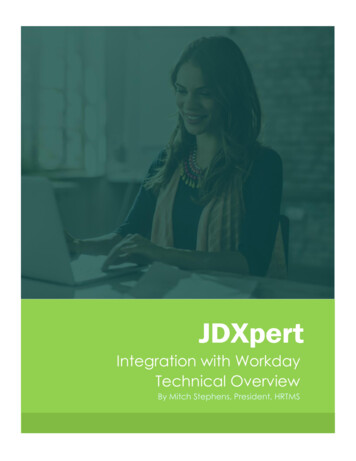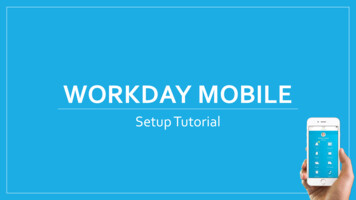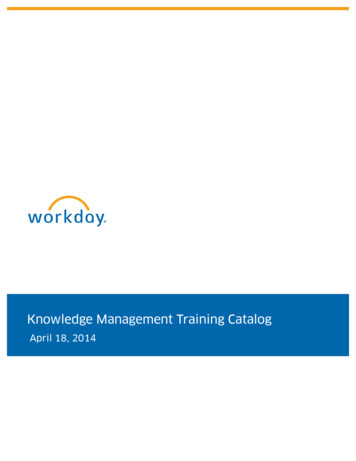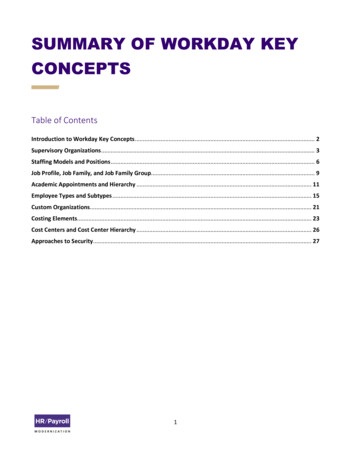
Transcription
SUMMARY OF WORKDAY KEYCONCEPTSTable of ContentsIntroduction to Workday Key Concepts . 2Supervisory Organizations . 3Staffing Models and Positions . 6Job Profile, Job Family, and Job Family Group. 9Academic Appointments and Hierarchy . 11Employee Types and Subtypes . 15Custom Organizations. 21Costing Elements. 23Cost Centers and Cost Center Hierarchy . 26Approaches to Security . 271
INTRODUCTION TO WORKDAYKEY CONCEPTSWorkday offers a new way to view and organize workers in an organization. Workday is a cloud-based systemthat streamlines processes and information across the entire University, allowing for organizationaltransparency and providing a number of benefits.This diagram depicts how information is organized in Workday.The sections that follow go into more detail about this organization structure and describe the key conceptscentral to understanding and working in Workday.2
SUPERVISORY ORGANIZATIONSKEY CONCEPT DESCRIPTIONSupervisory Organizations A Supervisory Organization is a logical grouping of employees who report to the same Manager.A Workday Manager is defined as the person who is ultimately accountable for the completion ofperformance reviews.To be assigned the Manager role, a worker must be a member of the superior SupervisoryOrganization.Supervisory Organizations do not:o Track finances.o Include unpaid faculty appointments; these are tracked via the Academic UnitHierarchy.The Supervisory Organization Hierarchy Supervisory Organizations are arranged in a University-wide hierarchy, which is essential to how datais organized within Workday, and it provides the structure to:o Create reports within and external to Workday.o Provide access to worker data to workers as well as to their supervisors.o Route actions through business processes to the appropriate reviewers and approvers.o Ensure only the appropriate people have access to employee data (through assigned securityroles).o Provide the framework for assigning security roles to workers.WHAT THIS MEANS TO UW There is currently no single source of data on the UW “reports to” structure in existing systems.Instead, we are using a number of limited organizational definitions (PUC, home department, orgcode, etc.) to segment workers in reports and integrations. The Supervisory Organization provides a singular, complete, and accurate representation of worker“reports to” relationships.Anticipated Benefits Provides a “reports to” view of workers.Produces greater clarity on how workers are functionally organized.Provides a flexible and scalable system of record and the ability to see changes in workforce over time.Allows access to systems or physical locations based on membership to a Supervisory Organizationor through the relationship of one Supervisory Organization to another.3
Anticipated Challenges Departments will have to make a conceptual shift in how they talk about and organize their workers.“Supervisory Organization Manager” has a specific meaning in Workday as it relates to a role.Departments must understand that regardless of a business title, such as Director, Supervisor,Assistant Dean, they will have a role of “Manager” in the Workday Supervisory Organization.Departments may have situations where they have multiple supervisors involved in decision-makingfor their workers. In these instances, they will have to choose who the “Manager” is for thatsupervisory organization and develop processes outside of Workday to ensure they are meeting theirdepartmental business needs.NAMING CONVENTIONSExample A: Naming Conventions for Supervisory OrganizationsThere is a governed naming convention for each Supervisory Organization, which represents the existingadministrative description of what those organizations do and represent. Organizations in Workday appearwith a code representing the unit, followed by the descriptive name for the Supervisory Org, followed by theperson currently occupying the Manager position:The Supervisory Org Display Name will be formatted as follows:Code: Supervisory Org Name (Manager’s Name)Ex. UW Med: UWMC - Administration (Geoff Austin)UW-IT: Learning Technologies (Nathan McKee)4
SUPPLEMENTAL INFORMATIONIllustration A: Basic Example of a Supervisory Organization Hierarchy5
STAFFING MODELS ANDPOSITIONSKEY CONCEPT DESCRIPTIONStaffing Model Staffing Models determine how jobs are defined and filled; they provide different levels of controlover staffing and they support different staffing goals.In Workday, every Supervisory Organization must be associated with a Staffing Model.Like many universities, the UW has opted to use two staffing models in Workday: PositionManagement and Job Management.The Position Management and Job Management models provide units with the option to choose thehiring method that most closely matches their needs, the flexibility of budgeting for positions, andthe ability to reflect how workers are managed within an organization’s structure. To see a diagramof Position Management versus Job Management, see Diagram A, below.Position Management Position Management is the primary, default staffing model used by the UW.With Position Management, organizations are staffed by creating, defining, and filling positions. Aposition is described as the “chair” that a worker fills when he or she is hired. That “chair” remains,even when the worker leaves, for example, through a job change or separation.With Position Management, units can:o Track and report on filled and unfilled positions (vacancy reporting).o Plan and budget for vacancies and filled positions.o Track position history.o Simplify security role assignments by attaching a role to a position rather than to anemployee.Position Management is required for the following employee types and subtypes:o Multiyear and indefinite Academic facultyo Research Associateso Staff – Regular, Fixed Term, Temporary, Fixed Duration LOA and Projecto Contingent workers that require a security role in Workday6
Job Management Job Management provides greater flexibility of position planning and the management of positions inWorkday.Job Management does not track worker history. When a worker in a Job Management organizationleaves, his or her “seat” disappears.Job Management allows units to do the following:o Set hiring restrictions equally to all jobs in a Supervisory Organization based on job family,job profile, worker type, location, and full- or part-time status, or set no hiring restrictionsfor the jobs in the organization.o Track and report on filled jobs only.o Use a single requisition to hire multiple workers (requisition fulfillment is not tied to aspecific position).Job Management is required for the following employee types and subtypes:o Academic faculty who have one-year appointments or lesso Senior Fellowso All studentso Contingent Workers (except for those who will manage other workers; those individualcontingent workers must be in a position)Diagram A: Position Management versus Job Management7
WHAT THIS MEANS TO THE UWAnticipated Benefits The implementation of two staffing models in Workday provides the following benefits:o Ability to match a hiring method to the particular needs of a unit.o Flexibility between budgeting for long term positions and immediate/high-turnoverstaffing needs.o Ability to reflect the way workers are managed in the Supervisory Organization structure.Position Management provides greater control over hiring, headcount reporting, vacancy reporting,and maintenance of role assignments. It also gives the necessary information to conduct a centralizedand standardized process for position planning, enabling units to plan and budget for vacancies andfilled position.Job Management provides greater flexibility in hiring, easy adjustment of staffing levels in order torespond to emerging or cyclic business needs, and removes the administrative burden fororganizations with consistent staffing changes.Anticipated Challenges Implementing two staffing models, while necessary to meet the needs of the University’s broadvariety of organizations, also introduces the following challenges:o More complex Supervisory Organization Hierarchyo More complicated reporting for units that use both Staffing Models8
JOB PROFILE, JOB FAMILY, ANDJOB FAMILY GROUPKEY CONCEPT DESCRIPTION Once you have determined whether a new position you are creating belongs in a PositionManagement or Job Management Organization, the next step is to determine the Job Profile.A Job Profile is a record of information about a job and includes a summary, description, and the job’skey characteristics, such as exempt status, pay rate type, job classification groups, and compensationgrade.The Job Profile is a key component to developing an effective workforce management system.Workday organizes all Job Profiles into Job Families, a grouping of Job Profiles, and a Job Family Group,a collection of Job Families.In Workday, when you create job openings or fill jobs and positions in a Supervisory Organization, youwill select from a collection of job profiles. Once the Job Profile is selected, the Job Family will default.Workday allows for a Job Profile to belong to one or more Job Families.Table A: Job Family Groups and their Associated Job FamiliesJOB FAMILY GROUPSTAFFJOB FAMILIESClassified Non UnionContract ClassifiedOther StaffProfessional StaffAcademic StaffEducatorExtension LecturersFaculty - Annual or ShorterFaculty-Indefinite and MultiYearLibrarianMedical Residents/FellowsSenior Fellows/TraineesACADEMIC PERSONNEL9
WHAT THIS MEANS TO UW Certain historical job codes from HEPPS are being converted to Job Profiles in Workday.While HEPPS allowed for the same job code to have a monthly or hourly paid designation, Workdaydoes not. Therefore, some job codes will become more than one Job Profile to delineate between paytype (e.g., hourly, monthly, stipend) and FLSA exemption (exempt or nonexempt).Anticipated Benefits Workday maintains a standardized skeleton containing a summary, description, and qualifications ofeach Job Profile, which streamline the creation of new positions.A naming convention will be used to make Job Profiles easily identifiable.More than one Employee Subtype may use the same Job Profile.Job Profiles will be in no more than two Job Families. Doing this makes Job Profiles more searchableand enables reporting (EEO, federal and state reporting, workers comp, etc.) when querying onspecific job classifications.Anticipated Challenges Job Profiles require careful maintenance to stay up to date. This includes but is not limited to:activating or deactivating, organizing Job Families and Job Family Groups, and ensuring correct FLSAdesignations similar to the maintenance in HEPPS.If any attributes of the Job Profile change, for example, in terms of union status or FLSA exemption,other values need to be kept in sync, like job classifications.As units create new positions, there will be a need for an in-depth knowledge of Job Profiles toidentify the appropriate one. The ISC, which is responsible for maintaining the Job Catalog, willprovide the resources necessary to help departments choose Job Profiles.10
ACADEMIC APPOINTMENTS ANDHIERARCHYKEY CONCEPT DESCRIPTIONAcademic Appointments Appointments in Workday are separate from positions. Academic Appointments track a person’s academicrelationships and the characteristics of those relationships, such as start dates, end dates, appointing unit,rank, etc.Academic Appointments can be updated in the event of a reappointment or promotion.Academic Appointments can be ended independent of a separation, such as in the case of nonreappointment of some one's adjunct appointment.A person can have multiple Academic Appointments in Workday.The following are Academic Appointment operating rules, as defined by Workday: Academic Appointments can be held by workers or by unpaid academic affiliates. All academics havean Academic Appointment in Workday. Academic Appointments are situated within the Academic Hierarchy, which is different from theSupervisory Organization Hierarchy.Academic Hierarchy Academic appointments are situated within the Academic Hierarchy, which is different from theSupervisory Org Hierarchy. The academic hierarchy configuration is designed to be flexible. It can accommodate various structures fordifferent units by assigning each unit to an appropriate “Level.” For example, some schools are undercolleges, and the academic administrator of the school is a director, whereas other schools have a dean. Both units are called a “school” but they are assigned different Levels in Workday. A school with a directoris assigned to the same level as a department with a chair. A school with a dean is as
Workday maintains a standardized skeleton containing a summary, description, and qualifications of each Job Profile, which streamline the creation of new positions. A naming convention will be used to make Job Profiles easily identifiable. More than one Employee Subtype may use the same Job Profile. Job Profiles will be in no more than two Job Families. Doing this makes Job Profiles more .
